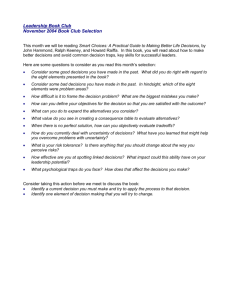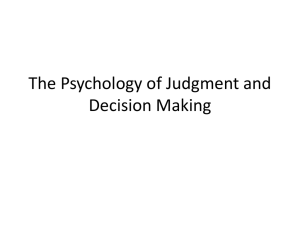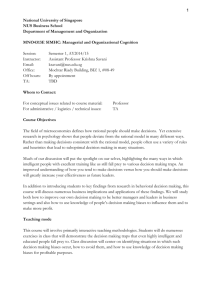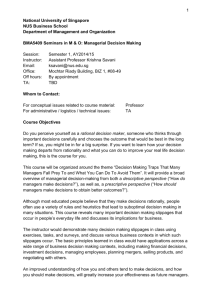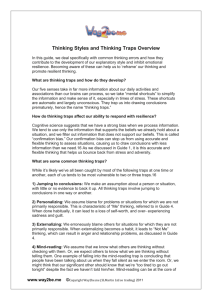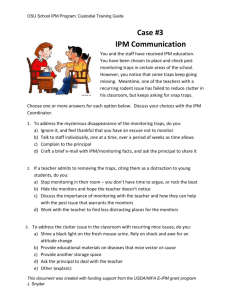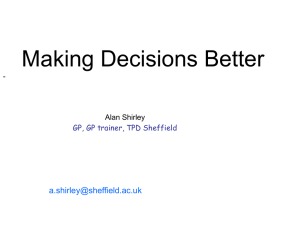The Psychology of Judgment and Decision Making
advertisement
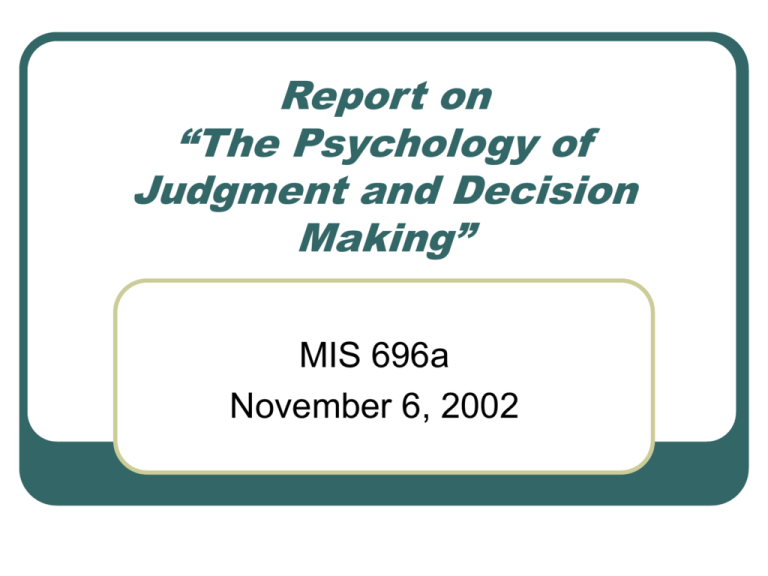
Report on “The Psychology of Judgment and Decision Making” MIS 696a November 6, 2002 Order of Business •Introduction •Section I: Perception, Memory, and Context •Section II: How Questions Affect Answers •Section III: Models and Decision Making •Section IV:Heuristics and Biases •Section V: The Social Side of Judgment and •Section VI: •Conclusion Decision Making Common Traps Introduction “There is no such thing as context-free decision making, All judgments and decisions rest on the way we interpret the world......” Scott Plous Whether we work individually, or in groups... Whether we are considering: Perception, Memory, Context, The Phrasing of Questions, or The Making of Decisions... We use Heuristics, have our Biases, are subject to Social and Group Influences, and can fall prey to many, many Traps and Pitfalls....... Section I: “We do not first see, then define, we define first and then see.” Walter Lippmann Perception, Memory, and Context We all Experience Selective Perception at Some Time We Generally See what we Expect to See • • • • Perceptual Denial Compromise Disruption Recognition Dominant Reaction Part Right, Part Not Rare, Little or No Perception Incongruity may be misinterpreted We Generally Experience what we Expect to Experience • If told we are drinking, many of us will act like it! And Selective Perception can be Significant Research Trap When conducting research, if we expect to see, or are motivated to see specific results, we are very likely to see those results! • You should understand your motivations and expectations going into a research project, and control for their possible influence on your interpretation of results. • Assume you are biased, at least a bit. • Ask yourself how you would have interpreted the data if you • didn’t have the motivations and expectations. Consult with peers who don’t share your motivations and expectations. We Also can Suffer From Cognitive Dissonance When do people experience “Cognitive Dissonance”? - when they simultaneously hold 2 thoughts that are psychologically inconsistent … Cognitive Dissonance Theory Proposed by Leon Festinger (1950) A “Motivational Theory” People try to justify the inconsistency between 2 conflicting thoughts … Natural Motivation Self-Perception Theory Daryl Bem (mid ’60s) Explains how people infer the causes of their behavior Based on 2 main premises: People discover their attitudes, emotions & other internal states by watching themselves behave in various situations To the extent that internal cues are weak, ambiguous, or uninterpretable, people are in much the same position as an outside observer when making these inferences. Predecisional & Postdecisional Dissonance Predecisional - Dissonance (or the prospect of dissonance) influences the decisions people make • Become more “liberated” after “been there - done that” Postdecisional - Dissonance (or the prospect of dissonance) follows a choice that has been already made • Once you “commit” the decisions become more “correct” Aronson suggests … If you want someone to form more positive attitudes toward an object, get him/her to commit himself to own that object If you want someone to soften his/her moral attitude toward some misdeed, tempt him/her so that he/she performs that deed; conversely, if you want someone to harden his moral attitudes toward a misdeed, tempt him/her – but not enough to induce him/her to commit the deed What do we learn? Changes in behavior can also lead to changes in attitude !! Cognitive Dissonance can be helpful in managing resources – people Getting them to commit to the work will result in increased dedication & effort Memory Memories are not fixed in storage, but re-constructed at the time of remembrance Memories are inter-linked – its difficult to remember every detail separately, but easy to remember a general scenario Hindsight Hindsight Bias “I-knew-it-all-along” effect Tendency to view what has already happened as relatively inevitable and obvious – without realizing that retrospective knowledge of the outcome is influencing one’s judgment Reducing Hindsight Bias Explicitly consider how past events might have turned out differently If one only considers the reasons why something turned out as it did, he/she runs a good risk of overestimating how inevitable that outcome was and how likely similar outcomes are in the future What do we learn? It is very crucial to ask relevant and exhaustive questions, considering different alternatives, to reduce “Hindsight Bias” in research work It is equally necessary to maintain careful notes and records of past events (meetings, important conversations, etc.), in order to avoid biases in memory Context Dependence Memory, by its very nature, highly dependent upon contextual factors Decision makers interpret new information in light of past experience and the context in which the material occurs The Contrast Effect Contrast Effect only occurs when the contrasted stimuli are similar to one another e.g. a 5’10” sports announcer looks very short when interviewing a team of basketball players, but looks very tall when interviewing race horse jockeys The Primacy & Recency Effects General Relationship between the position an entry occupies and the effect it has on judgments First Impression counts • Assumption: First piece of information is more important If there is a time lag between the first piece of information and the last, last one leaves a lasting impression • Short-term memory overrides the long-term memory Halo Effects We all have a number of general assumptions about what personality traits go together. The likelihood is that we like to see positive characteristics going along with other positive ones and vice versa Particularly powerful when we know relatively little about the person. What do we learn? Any comprehensive analysis of judgment & decision making must take context effects into account Keep an objective outlook towards your research – well grounded methodologies will help Understand people’s subjectivity while conducting experiments Don’t be a victim of Halo effects or do not try bank on the same as well…they are temporary Section 2: How Questions Affect Answers Effect of question framing and wording Factors that affect an answers Inconsistencies about attitude Implications for research Factors affecting answers Order of questions Context in which question appeared Question format, open or closed Presence of filters Presence of catch phrases Factors affecting answers Range of response alternatives Order of response alternatives Presence of middle categories Framing in terms of gains or losses Attitude Inconsistency Attitude-Attitude inconsistency Attitude-Behavior inconsistency • Abstract attitude unrelated to specific cases • Attitude not usually related to behavior Implications for research Aware of factors that effect results Compare results from multiple procedures Measure behavior than attitude Section III: Models and Decision Making Expected Utility Theory Describes How People Would Behave if they Thought Rationally Jon Von Neumann, Oskar Morgenstern (1947) The Rational Decision Making Model Rational D Model Compare Ordering Alternatives Dominance Cancellation Transitivity Continuity Invariance Reality Actual Events Feedback - Modify It’s Wrong What’s Wrong With The Rational Decision Making Model Paradoxes in Decision Making Allais Paradox 1 Alternative A: $1 Million For Sure 2 Alternative A: 11% - $1 Million | 89% - $0 Alternative B: 10% - $2.5 Million | 89% - $1 Million | 1% - $0 Alternative B: 10% - $2.5 Million | 90% - $0 Violates the RDM Cancellation Principle RDM Predicts: 1- A then 2-A Reality: 1-A, 2- B Prospect Theory Value Prospect Theory Value Function -$500 Gains Losses +$500 Adapted from Kahneman and Tversky Descriptive Models Descriptive Decision Making Models Satisficing Certainty Effect Pseudocertainty Regret Theory Multi Attribute Choice Non-Compensatory Strategies The More Important Dimension Lessons Learned Lesson Learned Section IV: HEURISTIC AND BIASES How do people come to their decisions? Decision Making Normative theories Heuristic Answer Representativeness Heuristic Advantage: • It reduces time and effort required for decision making. Disadvantage: • It might lead to systematic biases. Conjunction fallacy Linda is 31 years old, single, outspoken, and very bright. She majored in philosophy. As a student, she was deeply concerned with issues of discrimination and social justice , and also participated in antinuclear demonstrations. Please check off the most likely alternative. Linda is a bank teller. Linda is a bank teller and is active in the feminist movement. Conjunction fallacy Feminist bank tellers Bank tellers Feminists “Specific scenarios appear more likely than general ones because they are more representative of how we imagine particular events.” Gambler’s fallacy The belief that a successful outcome is due after a run of bad luck Hot hand A player has a better successful chance after having successful shots than after having missed a shot Neglecting base rates A reliance on representativeness leads people to ignore “base rate” information Nonregressive prediction Extreme performances tend to be followed by more average performances “Sports Illustrated Jinx” Availability Heuristic Most people estimate the frequency of an event by how easy it is to bring instances of the event to mind Imaginative prediction #8 in Reader Survey about causes of death • diabetes or homicide • tornado or lightning • car accident or stomach cancer Imaginative prediction Overestimate -easy to visualize -vividness Underestimate -hard to imagine -horrifying imagine Conclusion Don’t be misled by highly detailed scenarios Whenever possible, pay attention to base rates Remember that chance is not self-correcting Don’t misinterpret regression toward the mean Beware of wishful thinking Chapter 12: Probability and Risk Confusion of inverse Example: Were the chances of cancer given a positive test result roughly equals to the chances of a positive test result given cancer? No. How to avoid • Bayes theorem • Prior probability Probability Positive outcomes vs. negative outcomes Compound events Conservatism • Conjunctive: A and B • Disjunctive: A or B • The tendency: overestimate vs. underestimate Slowness to revise prior probability estimates Risk Highly subjective Biased in the direction of preexisting views • “voluntary” risk: from smoking, skiing • “involuntary” risk: from electric power generation • Technology supporters vs. opponents Implications for MIS Avoid negative biases • Maintain accurate records • minimize primacy and recency effects, availability biases • Beware of wishful thinking • Break compound events into simple events • System design Chapter 13: Anchoring and Adjustment What? • Insufficient adjustment up or down from an original starting value, or “anchor” Effects of arbitrary anchors • Estimates on the performance at problem- • solving task Stake out extreme initial position Anchoring Examples: How thick would a piece of paper be if it were folded in on itself 100 times, given an initial sheet of paper 0.1 millimeter thick? • Most people give estimates less than a few • yard. The correct answer is 1.27×1023 kilometers Reason: adjust upward insufficiently Implications for MIS Anchor values in our research How to avoid • Previous results that are unusually high or low • Generate an alternative anchor value in the • opposite direction Consider multiple anchors Section V The Social Side of Judgment And Decision Making By Jason J. Li Chapter 17: Social Influences People are social by nature, so their judgments and decisions are subject to social influences. How are personal decision makings affected by social factors? What shall we learn? Social Facilitation The presence of onlookers tends to • • enhance the performance of simple responses. but impair the performance of complex skills. Hey! Watch this. It’s only a piece of cake! * Choose an appropriate environment according to the complexity of task. Please leave me alone! I can’t focus! Social Loafing People do not work as hard in groups as they work alone. Diffusion of responsibility can have a powerful influence on judgment and decision making. Don’t look at me! Someone else will do it. I don’t have to work as hard as before. It’s none of my business! * Clarify everyone’s responsibility in a research group. Social comparison theory People have a need to evaluate their ability levels and the appropriateness of their opinions. • In the absence of objective nonsocial standards, people compare themselves with others, especially with those who are similar to them. * Benchmark with others’ research work. * Difference: Metrics are necessary! How do people think in groups? People tend to succumb the pressure of conformity. When groups are cohesive and relatively insulated from the influence of outsiders, group loyalty and pressures to conform can lead to “Groupthink”. * Keep our brain clear and rational! * Resist the tend of Conformity & Groupthink. Chapter 18: Group Judgments And Decisions Will a group make better judgments and decisions than an individual would? Do groups operate wit the same heuristics and biases as individuals? How to exert the potential of a group? Group Errors & Biases Many individual-level heuristics and biases appear to operate with equal force in groups. Group discussion often amplifies preexisting tendencies. * Be careful of the individual-level biases in group judgment and decision making. Are N heads better than 1? Groups usually perform somewhat better than average individuals; the best member of a group outperforms the group. Average(Xi) < ΣXi < Max(Xi) * Communication + Cooperation + Collaboration * Encourages all group members to express an opinion. * Use “Dictator Technique” in group research. The Perception of Randomness Recognize the difference between the probability of a particular event occurring in a particular situation, and the probability of some similar event occurring in some similar situation Be careful not to see patterns where they do not exist. Seeing a ‘hot hand’ may get you in ‘hot water’. Correlation, Causation, and Control “People often have difficulty assessing the covariation between two events, and they tend to rely heavily on positive occurrences of both events.” Both Illusory Correlations and Invisible Correlations are dangerous p. 163 Avoid ‘Causalation’ = “Just as correlation need not imply a causal connection, causation need not imply a strong correlation” CCC Guidelines Focus not only on positive, confirming cases, but also on cases lacking these characteristics Is the perceived relationship based on observations or expectations? Carefully distinguish between correlation and causation. Remember correlation does not always mean causation Attribution Theory Attribution is based on three sources of information: • Consensus: Do others behave similarly? • Distinctiveness: Does the situation make a • difference? Consistency: Does the same thing happen every time? The Fundamental Attribution Error Joe has trouble reading directions This is a really complex gizmo Joe John John couldn’t put together a sandwich There must be parts missing… John Joe Other Attribution Errors Self-Serving Bias I invented the Internet!!! Egocentric Bias I contributed much more than my colleagues • Co-authoring! Positivity Bias I couldn’t have done it alone…well, maybe… Could the economy be any worse? Avoiding Attribution Pitfalls Don’t ignore consensus information Ask “How would I have behaved?” Be sure to look for hidden causes, not just the most salient ones Section VI: Common Traps Common problems that beset decision makers Examples of Overconfidence Chernobyl Nuclear Disaster (April 25th -26th, 1986 Ukraine) P[ meltdown of the reactor ] <=1/10,000 Challenger Accident (January 28th , 1986 ) P[ catastrophic launch failure ] <=1/100,000 Attack on Pearl Harbor No problem in judgment and decision making is more prevalent and more potentially catastrophic than overconfidence (Dec. 7th, 1941 Oahu Hawaii) Confidence & Accuracy Confidence increased with the amount of information subjects read, but accuracy did not 60 Percentage of questions correct True accuracy Estimated accuracy 50 40 30 20 10 0 1 2 3 4 Amount of case study read by subjects Overconfidence in research Overconfidence in literature review What you have read is far from enough Overconfidence in doctoral dissertation management Just Do It ! Confirmation Bias “If a card has a vowel on one side, then it has an even number on the other side” If a card has a odd number on one side, then it has a consonant on the other side Which of the cards would you need to turn over in order to decide whether the person is lying? E K 4 7 Def: Confirmation bias refers to a preference for information that is consistent with a rule rather than information which opposes it Confirmation Bias in research Hypothesis Testing Positive test strategy VS. Negative test strategy Confirmation Bias Better Result Behavioral traps Time delay traps Ignorance traps Investment traps Deterioration traps Collective traps (Gross and Guyer, 1980) Examples of behavioral traps Time delay traps: Euphoria of drinking vs. Next day’s hangover Ignorance traps: Smoking Investment traps: “Sunk cost effect” Deterioration traps: Heroin addiction vs. Lung Cancer Collective traps: Rush-hour traffic Behavioral traps in research Behavioral traps almost happen everyday Traps are not always bad: intentionally trapping ourselves in an active and healthy research life Lets face it, we are all human! Conclusion There is no silver bullet to solve the fundamental problem: We are all human and rely on an extremely complex tool, our mind, which has evolved over millions of years to perform many functions in such a fashion that it facilitates individual and group survival, which does not necessarily equate to scientific consistency and/or accuracy! Conclusion We must shoulder the burden of having to hold our biases in check at all times. We can never tire of that burden, for when we cease to shoulder it then we are no longer scientists. There is one conciliation, the inherent biases our brain uses to rapidly form opinions and judgments can be held in check by actively examining them, by asking what-if questions, by questioning our work and seeking other explanations. Conclusion Generally Unbiased Q & A
